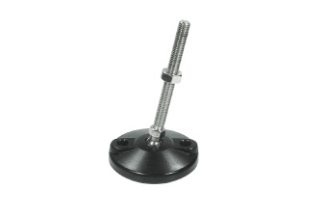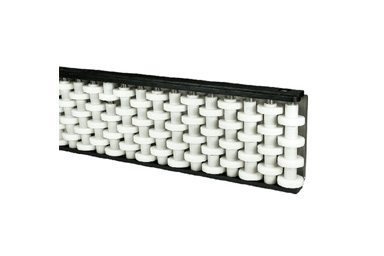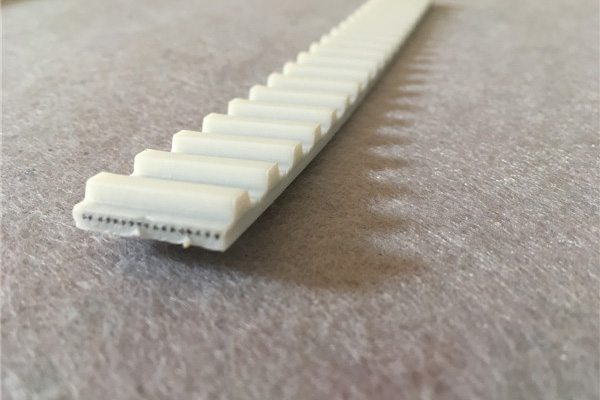Factory Free sample Modular Belts P=1″ Belt Har 100 flush grid for Luxemburg Manufacturer
Factory Free sample Modular Belts P=1″ Belt Har 100 flush grid for Luxemburg Manufacturer Detail:
Har 100 flush grid
Thickness: 9mm
Opening area: 31%
Our company has been qualified with ISO 9001:2000 quality system. The product strictly complies with the standard and procedures of ISO 9001, which ensures good product quality. So our products have some advantages, for example:
1. Easy installation and maintenance
2. High mechanical strength and wear resistance
3. Low friction coefficient
4. Excellent product handling
5. High performance
We are a leading manufacturer of modular belts with professional team; we can provide you with excellent quality items. This kind of modular belt can be used in the following industries:
Beverage industry such as acceleration, depletive and accumulation.
Food industry such as cool off lines and pack lines.
Meat industry such as tray pack line and metal detectors.
Our products are mainly used in bakery industry including dough transport, cooling lines, internal transport, metal detectors and packaging lines
Seafood applications including tray packing lines
spiral applications as proofing and freezing of croissants, cooling and resting
Bakery applications including raw dough handling, cooling lines and packing lines
Fruit vegetable applications including elevators, inspection tables and packaging lines.
Product detail pictures:
With superior technologies and facilities, strict quality command, reasonable cost, exceptional provider and close co-operation with customers, we've been devoted to delivering the best benefit for our buyers for Factory Free sample Modular Belts P=1″ Belt Har 100 flush grid for Luxemburg Manufacturer, The product will supply to all over the world, such as: South Korea, Reunion, Mayotte, Aiming to grow to be by far the most experienced supplier within this sector in Uganda, we keep researching on the creating procedure and raising the high quality of our principal items. Till now, the merchandise list has been updated on a regular basis and attracted customers from around the globe. Thorough data can be obtained in our web page and you'll be served with good quality consultant service by our after-sale team. They're about to allow you to get complete acknowledge about our products and make a satisfied negotiation. Small business check out to our factory in Uganda can also be welcome at any time. Hope to obtain your inquiries to get a happy co-operation.
Follow us at: https://plus.google.com/+tutorvista/
Check us out at https://chemistry.tutorvista.com/inorganic-chemistry/metallurgy.html
Blast Furnace
Modern furnaces are equipped with an array of supporting facilities to increase efficiency, such as ore storage yards where barges are unloaded. The raw materials are transferred to the stockhouse complex by ore bridges, or rail hoppers and ore transfer cars. Rail-mounted scale cars or computer controlled weight hoppers weigh out the various raw materials to yield the desired hot metal and slag chemistry. The raw materials are brought to the top of the blast furnace via a skip car powered by winches or conveyor belts.There are different ways in which the raw materials are charged into the blast furnace. Some blast furnaces use a “double bell” system where two “bells” are used to control the entry of the raw material into the blast furnace. The purpose of the two bells is to minimize the loss of hot gases in the blast furnace. First the raw materials are emptied into the upper or small bell. The bell is then rotated a predetermined amount in order to distribute the charge more accurately. The small bell then opens to empty the charge into the large bell. The small bell then closes, to seal the blast furnace, while the large bell dispenses the charge into the blast furnace.A more recent design is to use a “bell-less” system. These systems use multiple hoppers to contain each raw material, which is then discharged into the blast furnace through valves These valves are more accurate at controlling how much of each constituent is added, as compared to the skip or conveyor system, thereby increasing the efficiency of the furnace. Some of these bell-less systems also implement a chute in order to precisely control where the charge is placed.
The iron making blast furnace itself is built in the form of a tall chimney-like structure lined with refractory brick. Coke, limestone flux, and iron ore (iron oxide) are charged into the top of the furnace in a precise filling order which helps control gas flow and the chemical reactions inside the furnace. Four “uptakes” allow the hot, dirty gas to exit the furnace dome, while “bleeder valves” protect the top of the furnace from sudden gas pressure surges. When plugged, bleeder valves need to be cleaned with a bleeder cleaner. The coarse particles in the gas settle in the “dust catcher” and are dumped into a railroad car or truck for disposal, while the gas itself flows through a venturi scrubber and a gas cooler to reduce the temperature of the cleaned gas.The “casthouse” at the bottom half of the furnace contains the bustle pipe, tuyeres and the equipment for casting the liquid iron and slag. Once a “taphole” is drilled through the refractory clay plug, liquid iron and slag flow down a trough through a “skimmer” opening, separating the iron and slag. Modern, larger blast furnaces may have as many as four tapholes and two casthouses. Once the pig iron and slag has been tapped, the taphole is again plugged with refractory clay.The tuyeres are used to implement a hot blast, which is used to increase the efficiency of the blast furnace. The hot blast is directed into the furnace through water-cooled copper nozzles called tuyeres near the base. The hot blast temperature can be from 900 °C to 1300 °C (1600 °F to 2300 °F) depending on the stove design and condition. The temperatures they deal with may be 2000 °C to 2300 °C (3600 °F to 4200 °F). Oil, tar, natural gas, powdered coal and oxygen can also be injected into the furnace at tuyere level to combine with the coke to release additional energy which is necessary to increase productivity.
Please like our facebook page
https://www.facebook.com/tutorvista
It's really lucky to find such a professional and responsible manufacturer, the product quality is good and delivery is timely, very nice.


